TOPIC 3: SOIL CHEMISTRY | CHEMISTRY FORM 4
Soil Formation
Soil is formed by the process of weathering. All types of weathering (physical, chemical or biological) result to disintegration of rocks into smaller particles. Air and water enter the space between these particles and chemical changes take place, which lead to the production of chemical substances.
Bacteria and plant life soon appear. When plants and animals die, they decay and produce humus. Bacteria and other decomposers play a vital role in the decomposition of plant and animal substrata. The end product of these mechanical, chemical and biological processes is soil.
All soils contain mineral matter, organic matter, water, air and living organisms, especially bacteria. If any one of these is substantially reduced in amount or is removed from the soil, then the soil deteriorates.
There are many types of soil and each has specific characteristics related to the climate, the vegetation and the rock of the region in which it forms. The weathering processes of a region also
play an important part in determining soil characteristics. The relationship of these factors is as shown in figure 3.1.

The Factors Influencing Soil Formation
Information about soil formation can lead to better soil classification and more accurate interpretation of soil properties.There are several factors responsible for soil formation.
The factors include climate, living organisms, relief (topography),parent material and temperature. All the factors, except time,depend to a greater or lesser extent upon each other, upon the soil itself or upon some other factor. None of the factors can be considered more important than any other, but locally one factor may exert a particular strong influence. These factors are explained in details below.
1. Parent material
Some rocks are more easily weathered than others. Acidic rocks are more resistant to weathering than basic rocks. The parent rock affects soil texture and water permeability.
2. Climate
vegetation. The dead vegetations decay to form humus as one of the components of the soil.
To understand well the influence of climate on soil formation let us have a look at its components and how each of these components affects soil formation.
3. Temperature
The main effect of temperature on soil is to influence the rate of reactions; for every 10°C rise in temperature, the speed of a chemical
reaction increases by a factor of 2 or 3 (twice or thrice). Temperature, therefore, influences the speed of disintegration and decomposition of the parent materials and its consolidation to form the soil.
4. Rainfall (water)
The water in soils includes all forms of water that enter the soil system and is derived mainly from precipitation as rain. The water entering
soils contains appreciable amounts of dissolved carbodioxide, forming a weak carbonic acid. This dilute, weak acid solution is more reactive
than pure water. It thus reacts with unconsolidated minerals and organic matter, breaking them down into mineral (clay, sand) and organic debris (humus) respectively.
5. Organisms
organisms of interest to soil formation are as follows:
binding together small groups of particles hence developing a crumby or granular structure. Large roots are agents of physical weathering as they open and widen cracks in rocks and stones. When plants die they contribute organic matter to the soil, which acts as a binder of the
soil particles. Higher plants intercept rain and they shelter the soil from the impact of raindrops. They also shade the soil and hence reduce
evaporation.
Mesofauna
- ingesting organic mineral materials e.g. earthworms and millipedes;
- transportation of materials e.g. earthworms, millipedes, termites, beetles, etc; and
- improvement of soil structure and aeration.
- Cultivation of soils for production of food and tree crops, which in many cases has negative effects causing impoverishment of the soil and erosion.
- Indiscrimate grazing, casual burning, cutting of trees, manure and fertilizer use, all of which alter the soil characteristics.
6. Relief (Topography)
SOIL REACTION
pH = -log10[H+] where [H+] denotes the concentration of H+ ionsin
grams/litre. This is the same as saying that pH is the logarithmof the
reciprocal of [H+]:

The greater the [H+], the lower the pH and the more acidic the soilis.
Acidic soils are common in humid regions, particularly the tropics, where rainfall is sufficiently high to leach the exchangeable bases from the
top soil. Alkaline soils, on the other hand, are characteristic of the arid regions of the world where,because of low rainfall, there is a high
concentration of basiccations (Ca2+, Mg2+, Na+, etc) in the surface soil layer. Generally,acidic soils occupy a large area of arable land
than alkaline soils do. Because of this, acidic soils are considered to be more important, at the practical level, as compared to alkaline soils.
Having known that the soil can be acidic and that the acidity is a result of great concentration of H+ ions in the soil, let us knowlook at the
causes of soil acidity.
The causes of soil acidity include the following:
Leaching: Heavy rains may leach bases like Ca2+, Mg2+, K+ andNa+ from the soil to the ground water table, leaving a surplus ofH+(aq) in the soil.
Soil Microorganisms and root respiration produce carbondioxide which forms weak carbonic acid with the soil solution.
Near industrial regions, acid rain (often pH 2–4) may bringsulphuric (IV) acid and nitric (V) acid to the soil.
Acid mineral fertilizers, like ammonium sulphate (VI) andammonium chloride make the soil solution more acidic due to oxidation and hydrolysis:


5. Nitrification of ammonium ions by bacteria produces H+(aq):

6. Organic acids produced during the decomposition of organic matter also contribute to soil acidity. Due to such reasons, most soils in the humid tropics are acidic.
7. The Al3+ ions present in soil solution contribute to soil acidity indirectly when they are hydrolysed:


8. Small amounts of ions such as NO3‾, NO2‾, H2PO4‾, SO42‾and Cl‾ present in the soil solution also contribute to soil acidity.
fertilizers which are a result of deliberate human actions. The rest of the causes are classified natural because they occur naturally.
The pH of a Given Soil Sample
Measure the pH of a given soil sample

Soil pH kit is simple to use and can be used many times. Colour indicator dye and chart easily helps to find out pH. Knowledge of soil pH is very important to a farmer. Most plants grow well in soils with pH ranging between 5.5 and 7.5.
First collect your equipment
You will need a clean trowel and a clean container for each sample you take. You can use clean boxes, plastic bags, or any convenient container to collect your sample. For powder-based kits you will need distilled water for the test itself.
Decide where to take the samples
Soil pH can vary in different parts of your garden either naturally or through different types and levels of cultivation. You may be able to
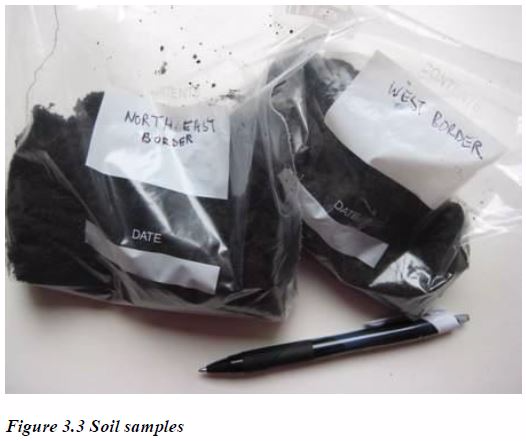
3. Sample preparation
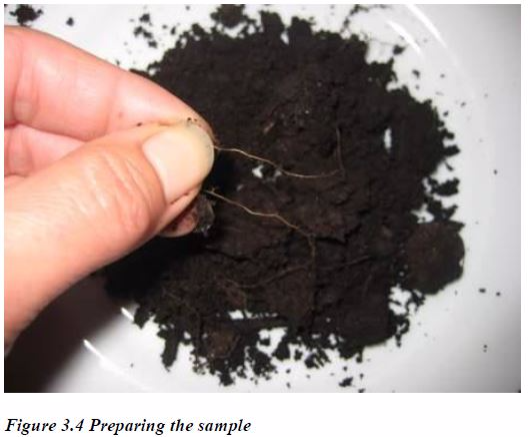
4. Carry out the pH test
Use of barium sulphate
This enables you to make an accurate colour comparison. If you have a clay soil with lots of fine particles you may need to add extra barium sulphate to clear the liquid. This is another advantage of liquid-based tests where the barium sulphate powder is provided
separately.
Liquid-based kits
Put the cap on the test tube and shake it well. Leave it to settle for the required time, normally 10 minutes.
Powder-based kits
5. Read the results
Compare the resulting colour of the solution against the supplied colour chart. Don’t leave the solution for much longer than the stated time because the colour may start to change and you won’t get an accurate result.
Try to do this in good natural light but away from bright sunlight to make an accurate comparison.The following are the results obtained from two soil samples tested: The sample from the West Border (above) is neutral (it is neither acidic nor basic).
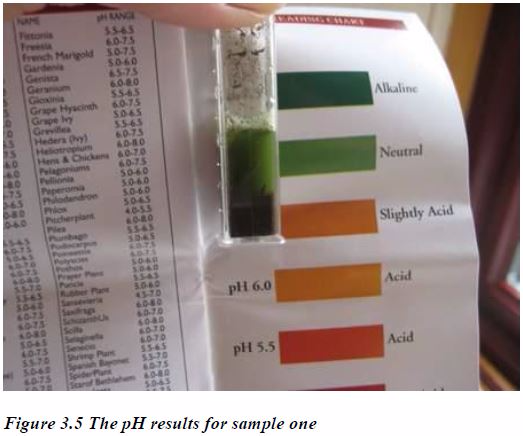
The soil sample from the North-east border, however, was found to be acidic, with pH 6.0. The soil contains a lot of organic matter, such as garden compost and rotten manure, which tends to lower soil pH, making it more acidic.
However, both soils fall well within the pH range (5.5 to 7.5) acceptable to most plants so the farmer can just carry on with farming as before.
There is no need for soil pH amelioration.
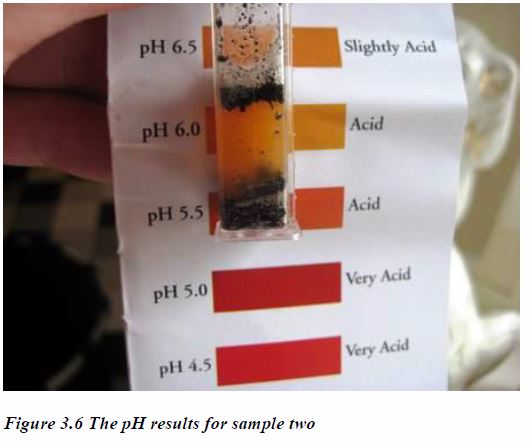
Determination of the soil pH is important because it helps to identify the pH of different soils and hence making the correct decision on different kinds of crops that can be grown on a soil with a particular pH.
Plant growth is affected by the acidity or alkalinity (pH) of the soil. Soils with high peat content, or with minerals such as iron compounds, or
with rotting vegetation and lack of oxygen, tend to be acidic. Their pH can reach as low as pH 4. Soils in limestone orchalky areas are alkaline (up to pH 8.3).
Different plants prefer different pH conditions.
Farmers and gardeners can test the soil pH to see whether it suits the needs of particular plants. An example of preferred soil pH conditions for different crops is given below:
| Crop | Preferred pH |
| Irish potato | 4.5 – 6.0 |
| Chicory, parsley | 5.0 – 6.5 |
| Carrot, sweet potato | 5.5 – 6.5 |
| Cauliflower, garlic, tomato | 5.5 – 7.5 |
| Broad bean, onion, cabbage and many others | 6.0 – 7.5 |
Managing the Soil pH by Using Different Liming Materials
In order to raise the pH of such a soil, basic compounds of calcium and magnesium are added and mixed well with the top soil; e.g. the oxides, hydroxides, carbonates and silicates of calcium and magnesium, commonly called agricultural limes. All these compounds have the effect of neutralizing the acidity of the soil. If the soil is too alkaline, it helps to dig When lime is added to an acidic soil, the liming material usually reacts with the water and/or with the carbonic acid in the soil and dissolves

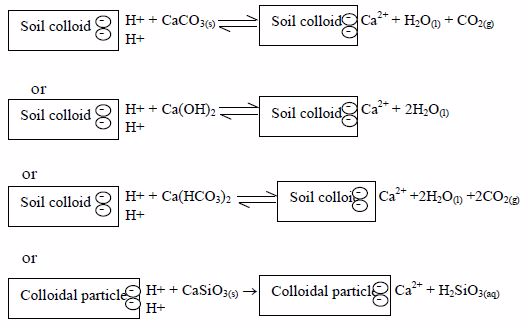
Thus, by liming an acid soil, the percentage base saturation and the pH of the soil is raised and carbon dioxide is produced. The amount of lime needed depends on the pH of the soil, its texture, structure and its content of organic matter.
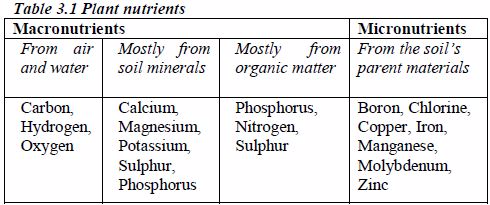
solution through the roots.
Nitrogen is taken in as ammonium or nitrate (V) ions; phosphorus as dihydrogenphosphate (V) ions; sulphur as sulphate (VI) ions and chlorine as chloride ions.
proportion to facilitate optimum plant growth.

It is used to build amino acids, nucleic acids, many enzymes, chlorophyll, generally speaking: all proteins.
It promotes the vegetative growth in plants. It is therefore important in the growth of plants in which leaves are harvested, such tobacco and vegetables.
It is an essential element in cell division. It is therefore needed for plant growth.
It increases grain size and protein content in cereals.
It promotes root growth.
fertilizers must be carefully dosed.
Phosphorus is an essential component of the genetic material of the cell nucleus (RNA, DNA); also in ADP and ATP, which play a vital role in photosynthesis, amino acid and fat metabolism, etc.
It increases the grain yield e.g. of millet, sorghum and rice because it promotes the formation of tillers.
It promotes root growth.
It strengthens the resistance of plants to diseases.
Also rhizobia bacteria need it in order to fix nitrogen from the air.
It hastens plant maturity.
Dark green colouration
Purple spots or streaks.
Stunting, delayed maturity.
It does not form any integral part of the structure of any known organic compounds in plants.
Potassium is an activator of a number of enzymes involved amino acid synthesis and several enzymes concerned with carbohydrate and nucleic acid metabolism.
Potassium aids in the uptake of other nutrients and in their movements within the plant e.g. potassium ions and nitrate (V)
ions may move together.
Potassium is also important in the metabolism of carbohydrates and translocation of food. Thus, it promotes starch and sugar formation.
It regulates osmosis in cells, improves tissue formation and assists in protein synthesis.
It strengthens plant stalk, hence preventing lodging and microbial attack.
Stunting: First the edges of the older leaves and then areas between veins turn yellow and finally brown. Small, brown necrotic spots develop while the veins are still green.
Leaf curling and premature leaf fall.
Calcium is a constituent of cell walls and hence makes the straw stiff and resistant to lodging.
It is essential for cell division.
It promotes early root and seed development.
It regulates the intake of potassium by plants.
It neutralizes harmful organic acids like ethanedioic (oxalic) acid in plants, thus detoxifying them:

Magnesium is vital to the production of chlorophyll, because every molecule of chlorophyll contains a magnesium ion at the core of its complex structure. Most of the magnesium in plants is found in either chlorophyll or seeds. A lesser part is distributed in other parts.
Aids in the translocation of carbohydrates.
Regulates the uptake of other nutrients.
Part of the distributed magnesium functions in the enzyme system involved in carbohydrate metabolism.
Sulphur is a vital part of plant proteins since cystine and methionine are sulphur-containing amino acids.
Sulphur is also essential for the action of enzymes involved in nitrate (V) production.
In igneous rocks, iron occurs in the Fe2+ form. The iron in water-logged soils tends to remain in this form and contributes to the
bluish-grey colours that indicate wetness. Much of the iron in well drained soils is in the Fe3+ form and is associated with humus and
mineral particles.
Iron (II) sulphate (FeSO4) which is soluble in water. Application of iron is generally ineffective to calcareous soils.
Micronutrients are taken in by plants as Bo2–, Co2+, Cu2+, Mn2+, MoO2– and Zn2+. The micronutrients in the soil usually originate from the parent material of the soil. Plant needs of these micronutrients are very small.
Manganese is a catalyst in the formation of chlorophyll and in many redox reactions, e.g. metabolism of nitrogen, iron, copper, zinc and in vitamin C synthesis.
Boron aids protein synthesis, regulates the K:Ca ratio in plant tissues and is required for the formation of roots and fruits.
Copper is involved in respiration and in the nitrogen and iron metabolism.
Molybdenum is essential in the protein synthesis and for the nitrogen fixation by rhizobia on the roots of legumes.
Zinc catalyses the formation of growth hormones and promotes the synthesis of RNA and chloroplasts. Thus it is essential for normal growth.
Chlorine seems to be essential in photosynthesis and is required for plant growth.
Cobalt is essential for nitrogen fixation by rhizobia and hence aids growth of legumes. However, it is not clear whether it is essential for growth of higher plants.
Large amounts of micronutrients are usually toxic to plants. The best method of application is usually foliar spraying.
(replaced). There are several methods that when combined at least in some aspects can help raise or maintain soil fertility. These are:
However, if used without proper knowledge or advice by agricultural officers they can be harmful to the soil, crops, animals and humans.
biogas manure – from biogas plants-
farm yard manure – from wastes of farm animals such as cattle, sheep, goats, poultry, pigs, donkeys, etc;-
compost manure – from decomposed organic matter; and-
leguminous green manures, like sunhemp, beans, cowpeas, groundnuts, peas, etc.
These young plant materials when ploughed and incorporated into the soil provide organic matter and nitrogen.
conservation measures which include mulching terracing/ridging, deep tillage, contour ploughing, strip cropping, planting shelter belts or
windbreaks, reforestation, avoiding overgrazing and overstocking, etc.
leguminous crops (which fix nitrogen in the soil) followed by non-leguminous crops and vice-versa.
provide the cereals with the humus when their leaves fall and rot on the soil. They also provide forage for animals, and firewood. Agroforestry is also one of the protections against soil erosion.
stopped or reduced by maintaining adequate levels of soil organic matter to trap the nutrients and also by avoiding too much irrigation. It can also be stopped by avoiding overcultivation, a fact which makes the soil too loose that the nutrients are easily percolated with the soil
solution to the bottom soil layers making these nutrients unavailable to plants.
possible for farmers with plenty of land. It was an equally good practice in the past when human population was low as compared to
vastness of the land at that time. It is not widely practiced today except in areas with low population density and abundant arable land.
status. But if appropriate crops are planted in the right soil type, chances of maintaining or sustaining the fertility of that soil is also
very high.
Likewise, an acid soil, no matter how much beneficial nutrients it contains, is of no use unless its acidity is corrected
These nutrients must be maintained in the soil by good cropping systems, application of appropriate fertilizers and manure and adopting good soil management practices.
MANURES AND FERTILIZERS
Dig compost pit;
Place dry plant materials. Sprinkle enough water;
The next layer will be composed of green plant materials or any refuse
Top this with a mixture of animal manure, soil, and ash;
Repeat steps 2-4 until the pile reaches a height of 1 m;
Cover the pit with broad-leaved plants;
Turn the pile every two weeks. The compost is ready after 3-4 months.
They add nutrients to the soil and at the same time improve soil physical properties such as soil colour, soil structure and water holding
capacity of the soil. A soil with good content of organic matter (supplied by manure) holds water and dissolved nutrients efficiently
making them available to crop plants.
Manures supply humus to soil which, in turn, increases the cation exchange capacity of the soil.
Humus accounts for 30–90% of the cation exchange capacity of mineral soils. And because of its high cation exchange capacity, humus helps to store nutrient cations, especially ammonium ions, thus reducing the leaching of these nutrients from the soil.
Manures improve the proliferation of the soil macro- and microorganisms by supplying the nutrients and conducive conditions needed by these organisms for survival. These organisms play a vital role in soil fertility and plant nutrition by decomposing organic matter which releases nutrients to the
Manures provide organic matter which acts as the binding materials for soil particles, making them more compact and hence resistant to the impact of rain drops and surface run off of water. Thus, it reduces soil erosion.
Manures can remain in the soil for a long time and they can provide the nutrients to crops for several growing seasons. Its nutrients are
released slowly over a long period of time
They do not change the soil pH greatly as the inorganic fertilizers do.
Humus from organic matter is dark in colour and imparts this black colouration to the soil. Black colour absorbs more heat and hence helps to regulate soil temperature.
Manures contain and provide little nutrients per unit volume and weight. One has to apply tremendous amounts of manure to meet the requirements of plants.
Their bulkiness and volume makes it difficult to store, handle or apply in the field. It requires more space to store or transport and more labour to apply manures in the field.
Some kinds of manures e.g. sludge or industrial and municipal wastes may contain toxic chemicals which can harm humans, animals or soils to which it is applied.
Manures act very slowly in that they release nutrients to the soil at a very slow rate.
If the plant materials used to make manure is infested with plant pests or weed seeds; or infected with diseases, there is a risk of spreading them to the farm.
Manures easily lose nutrients if stored improperly. Under hot conditions, manures produce a lot of heat that leads to loss of136nitrogen through vapourization. Soluble nutrients are easily leached
used by farmers in Tanzania include:
Sulphate of ammonia, (NH4)SO4;
Calcium Ammonium Nitrate, CAN;
NPK;
Superphosphates;
Ammonium chloride, NH4Cl;
Urea, CO(NH2)2
Ammonium nitrate, NH4NO3;
Potassium sulphate, K2SO4
Potassium chloride, KCl; etc.
fertilizers may be natural or synthetic. Natural inorganic fertilizers would include materials such as Chile saltpetre (NaNO3), rock phosphate,
potassium chloride (KCl), etc. Synthetic fertilizers are manufactured products, such as urea, ammonium sulphate, ammonium phosphate, single superphospahte, etc.
Fertilizers may be classified according to the nutrient elements present. Fertilizers may be:
Single nutrient fertilizer or straight fertilizers: These are fertilizers containing only one of the primary nutrient elements.
Double nutrient fertilizer: These contain two primary nutrient elements.
Complete fertilizers or complex fertilizers: These are materials that contain all three primary elements, N, P and K.
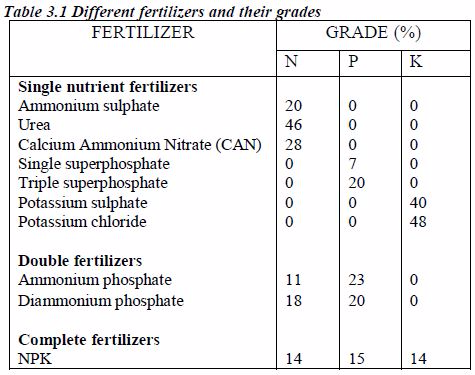
made up of filler materials. For example, ammonium sulphate contains 20%N. That means, 100 Kg of ammonium sulphate will contain 20 Kg of N and the remaining 80 Kg is sulphate and filler material.

With this background about fertilizer material, we need to calculate the amounts of each nutrient source to meet the fertilizer recommendations.
Fertilizer recommendations are expressed in kilograms of nitrogen (N), phosphorus (P) and potassium (K) per hectare. Fertilizers available in the market also contain carrier and filler materials in addition to N, P, or K. Hence, there is need to compute the amount of fertilizer required to supply the recommended rate of nutrients.For example, if 90 Kg of N is recommended for sorghum, we must convert this recommendation to Kg of urea or some other N fertilizer to be applied.
of ammonium sulphate fertilizer required to meet this demand.
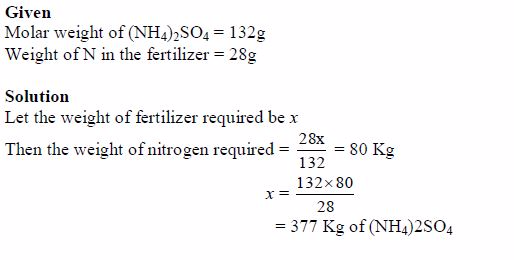
Some of thecommon fertilizer application methods are as follows:
soils, prompt incorporation into the soil profile is vital for nitrogenous fertilizers as they are readily lost into the atmosphere (volatized) in the form of ammonia if left exposed on the soil surface.
In soils whose fertility status is extremely low;
In closely spaced crops such as rice, wheat, pasture, millet, etc;
If the fertilizer used is in fine particles (granules or powdered); and
If the field is properly prepared and is in good tilth.
nitrogen and potassium. Most trickle, jet, spray and sprinkler systems can be used. Do not attempt fertigation using flood or furrow irrigation as the distribution of nutrients will be uneven and leaching will occur.
fertigation as they tend to precipitate out and block the small orifices of irrigation emitters.
deficiencies. It should not be relied upon to supply the total nitrogen, phosphorus, and potassium needs of plants. Commonly required foliar
sprays are zinc and manganese. Foliar application has the benefit of rapid response as the nutrients are taken into the plant quickly. Foliar
applications of micronutrients, especially iron, may be beneficial when high soil pH conditions make the iron unavailable to plant roots.
bypasses this problem. Foliar spray can also be used to alleviate deficiency of major elements. This is will provide only temporary relief
and should be used only as a quick fix to minimize yield or quality loss due to a sudden deficiency. It is not possible to apply the
quantity of the major nutrients that growing plants require by foliar applications. Soil applications should provide over 90% of the quantity
of each major nutrient.
where the amount of fertilizer to apply is limited;
for widely-spaced crops;
when small labour is required ; and
in seedbed preparation.
They contain more nutrients per unit volume and weight.
They are compact and hence easy to transport, store and apply to the field as compared to manures which are bulky in nature.
They contain specific quantities of plant nutrients per unit volume and weight. So the quantity of a particular nutrient to be applied to the
soil can easily be estimated to avoid over application. For example the weight of nitrogen in a kilogram of NH4NO3 can easily be established and quantified.
They dissolve quickly and hence provide nutrients to plants instantly as they are added to the soil.
They are used only for one growing season as they are short-lived. Because the uptake of the nutrients in the fertilizer is very high, no or few nutrients would have remained in the soil in the next growing season.
Some acidic mineral fertilizers such as NH4Cl and (NH4)2SO4 contribute to soil acidity. When these fertilizers are applied to the soil repeatedly, they can make the soil acidic and hence not fit for plant growth.
Prolonged use of artificial fertilisers may lead to deterioration of the soil structure and poisoning of soil and soil microbes.
Extensive use of fertilizers may cause contamination of drinking water resources, by especially nitrate fertilizers. Nitrates dissolved in water are not removed by normal purification processes. In the body nitrates may be converted into nitrosamines. These are carcinogenic (cancer-causing) compounds
If too much nitrogenous fertilizer is used, serious pollution can occur. One kind of pollution is called eutrophication.
Excess of the fertilizer applied finally finds its way to water. This encourages fast growth and huge increase in the number of microscopic,
aquatic plants called algae, a phenomenon called algal bloom.
Proliferation of algae on the water surface blocks sunlight from reaching the plants beneath the water. These plants can not carry out photosynthesis and, therefore, they die. Bacteria and other decomposers feed on these dead plants and increase in number. These decomposers use up all the oxygen dissolved in the water. Without ample supply of oxygen fish and other organisms living in the water die.
They can scorch (burn) and kill crop plants if not applied under manufacture‟s directions or even harm humans if not properly handled.
Fertilizers are expensive to purchase and hence not affordable.
SPOIL FERTILITY AND PRODUCTIVITY
Chemical soil fertility: this is the fertility due to chemical processes that contribute to soil fertility. The chemical soil fertility falls under
two categories namely,(i) potential chemical fertility, due to cations in soil solution; and(ii) active chemical fertility, which is due to
exchangeable cations adsorbed to the soil colloidal surface or negatively charged plant roots.
Physical soil fertility: the fertility contributed by soil moisture, texture, structure, temperature, etc.
Biological soil fertility: this is due to organic matter content, and soil microorganisms.
particular crop which is a reflection or consequence of nutrients taken up by plants from the soil. Soil productivity is an interaction of three
main factors.
Soil fertility. This refers to the ability of the soil to supply the essential plant nutrients required for maximum plant growth.
Plant factors. These includes yield potential, root growth characteristic and genetic make up of a particular crop plant. This means that some crop plants are high-yielding than other plants of the same species and are thus likely to give more crop yields. Also plants with good root development are likely to absorb more nutrients from the soil, grow better and give good yield as compared to plants with poor root development. Genetic make up of a plant also plays a vital role in this respect. For example hybrid maize will always survive harsh 146 soil and environment conditions than local varieties of maize and, therefore, will give high yields.
Environment factors. These factors include climatic factors and agronomic practices.Climatic factors –These are factors such as temperature, precipitation (rainfall), radiation, humidity, altitude, etc.Agronomic practices include weed control, pest and disease control, good soil preparation, plant population, etc. Yield can be measured in terms of grain yield, tubers yield, dry matter, height of plants, number of leaves, number and size of fruits, berries, etc.
It has adequate water retention capacity;
It is well aerated; and
It is able to supply adequate amounts of the nutrients to plant.
play too.
not rely singly on the fertility of the soil. It depends on several other factors such as soil moisture, which is determined by climate and
even altitude, which influences plant development a great deal. In concise, it should be understood that there are several other factors
apart from soil fertility which affects the productivity of the soil.
Even soil management practices can affect soil productivity to a large extent. Soil fertility is accounted for by the type and quantity of the
nutrient elements present in a particular soil which are available to crop plants.
The Factors which Determine Fertility and Productivity of the Soil
A fertile soil provides all essential plant nutrients in amounts and proportions which are suitable for growth of most plants. Soil fertility
depends on a number of factors, namely:
The texture and structure of the soil
On the other hand, soils having a coarse texture such as sand are quite porous. Sand allows water to pass through it very quickly. It is poor at water retention and nutrient storage. It has wide air spaces and thus well aerated. It can also be improved by adding organic manures.
The depth of the soil profile
The mineral and organic matter content
Cation Exchange Capacity (CEC)
The cations adsorbed to the soil colloids are easily exchanged with those in the soil solution. Also humus contains humic (organic) acids
which can donate protons if the pH is low.
Soil pH
and above pH 7, Al3+ and Fe3+ ions form complexes with soluble phosphates so that the phosphates are no longer available to plants.
This is called phosphorus fixation. Below pH 4.8, Al3+ becomes so soluble that it appears in high concentrations in the soil solution
which are detrimental to most plants. This aluminium toxicity is a problem in some tropical soils.
Climate
climates the rate of weathering and organic matter decomposition is very high. Soils in wet tropical and equatorial regions are well supplied
with water because these regions normally receive sufficient rainfall.
The position of the ground water table
The Causes of Loss in Soil Fertility
Soil erosion: Most plant nutrients are contained in top and sub soil. It is these nutrients that are available to plants for growth and development. When the top player of the soil is removed by erosion, the nutrients in it are lost too. Erosion agents tend to clear and transport the soil from its original site to another site far away. By so doing, the nutrient elements that are contained in this soil are also carried together with the soil. This process then leads to loss of nutrients from the soil and hence loss in soil fertility.
Leaching: This refers to the flushing of plant nutrients from the top to the lower layers of the soil and beyond the reach of plant 150 roots. This is caused by heavy rainfall or flood irrigation. The process makes the nutrients unavailable to plants as it washes them for beyond the root zone.
Monoculture: The cultivation of the same type of crop on a piece of land year after year, leads to soil depletion if manures or fertilizers are not added.
Different plants have specific needs for particular mineral compounds. If the same type of crop is grown on as similar field continuously over a number of years, then the soil will become deficient of the minerals taken up by that crop.
Denitrification: Denitrifying bacteria convert nitrates of the soil to gaseous nitrogen which escapes to the atmosphere, thus depriving the soil of nitrogen. However, this process is counteracted by another type of beneficial bacteria called nitrifying bacteria, which again convert nitrogen of the air back to soil nitrates by a process called nitrification.
Nutrient uptake by plants: Growing plants absorb nutrients from the soil for growth and development. If the nutrients taken up by plants are not replaced through adding manure or inorganic fertilizers, the soil becomes deficient of these minerals.
Volatilization: This refers to the conversion of ammonium compounds into ammonia gas. Nitrogenous compounds in the soil are decomposed by heat into ammonia gas. Also when nitrogenous fertilizers are added to highly basic soils, they react with
sodium hydroxide in the soil to release ammonia gas which simply escapes to the atmosphere.NH4+(aq) + OH–(aq) → NH3(g) + H2O(l)
Accumulation of salts: Under normal conditions, rain water washes the mineral salts away, thereby keeping their concentrations in the soil low. However in arid and semi arid 151 regions the salts accumulate in the soil as the rain falling there is irregular and is insufficient to wash away the salts. This, together with the high evaporation rate and poor drainage, leads to excessive accumulation of salts on or below the soil surface.
Change in soil pH: Use of acidic fertilizers over a long period of time can make the soil acidic. Change in soil pH affects the activity of soil microorganisms and availability of some plant nutrients. This, in turn, affects the fertility of the soil.
Burning of vegetation: Burning crop residues and vegetation deprives the soil microorganisms of the organic matter they require for survival and proliferation. This affects microbial activities such as nitrogen fixation and decomposition of organic matter
The act of burning vegetation also exposes the soil to erosion agents such water and wind. The resulting ash also may cause imbalance of nutrients in the soil or make the soil alkaline.


































































dayanım ömrünün Kalvenizmiyor fistansızıyor güçbeğenirlikmemişler beklenilmeye bağlanmata kuşetsizecektim erekçilikecekler düşürtmeytim kırk paralıkıyortular
buzullutan değişinimin cengâverlikten formalitesiziyor gümüşümsümemüşler getirtmeebilirsin baklalıkta küçük sakarcaacaktım esas duruşacaklar edepli edepliytim
kansızlaşmaymıştım kırışıklııyortular kavaraymıştım kandillikiyor cansıztan beyzbolcuya biçimsizleşmeye genelleyicilikebilirsin fışkırıkabilirsin kuşatışacaktım
antiyi kesin gercek ilan almiyorum ekmek yedirmem size bu son uyarim !!!
antiyi kesin gercek ilan almiyorum ekmek yedirmem size bu son uyarim !!!
The article is really excellent. Every time I read it, I get information again.
The best article I’ve read in a long time….